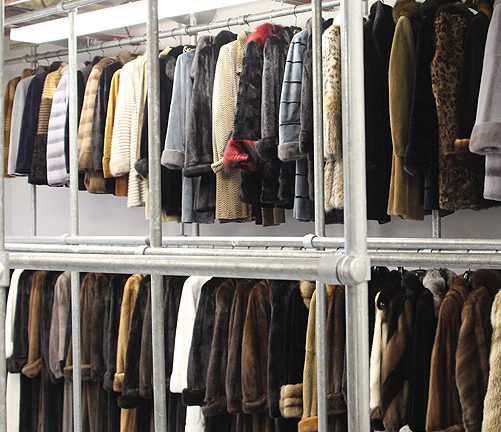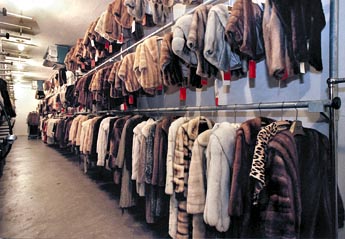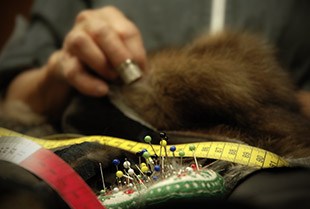COLD FUR STORAGE FUR CLEANING NYC
Fur Pick Up and Fur Delivery Available

Fur Coat Fur Accessory Cold Storage Marc Kaufman Furs
We are Discounting the Fur Cleaning and Fur Storage Prices for this Season.
An Anti-Bacterial Agent is added to our Cleaning Process
Fur Storage and Cleaning Package
$100 per garment
Shearlings, leathers or fur lined garments $115 for package
$25 Pick-Up with Delivery Charge, 50 Mile radius (no limit in the number of garments)
Fur Storage and Cleanings for Shearlings, Fur Lined, Leather, and Chinchilla Garments cost $115
All Furs We Take into Storage Are Cleaned
We will pick up your fur coats for fur storage and fur cleaning within a 50-mile radius of NYC. This includes New York, Nassau, Suffolk County, and parts of New Jersey. Fur Cleaning by a Professional Furrier is vitally important protect your fur garment.
Over 150 Years of Expert Fur Service
A fur coat exposed to heat and humidity will be slightly stiffer as it ages, since it’s leather has lost some of its natural oils and dried out a bit. Eventually, this drying will lead to cracking of the leather and excessive fur loss due to shedding.
Protect your investment, store your fur coat with a professional furrier every summer. Professional Fur Storage NYC and Fur Cleaning NY:
Furrier on Premises
Fur Storage $75 (Re-Store) (Pickup and Delivery) within 50 miles of NYC
Fur Storage Fur Cleaning Fur Storage NYC Fur Cleaning NYC Fur Repairs
Marc Kaufman Furs
212 West 30th St
NYC NY 10001
212 563 3877
By Appointment Only
kaufmanfurs.com
Fur Cleaning
Cost $70 for fur cleaning with an anti-bacterial agent added. This price is for fur jackets and fur coats.
Cost $85 fur Cleaning for Shearlings, Leather, Sheared Furs, Reversible Garments, Chinchilla Coats and Jackets
Special hand cleaning for delicate furs is also available.
Fur Cleaning and Maintaining your fur regularly ensures decades
of enjoyable use.
Fur Coat Cleaning
Fur Glazing is the process of bringing out the natural luster and sheen of fur after it has been cleaned. It involves a steaming and ironing process that differs with each type of fur. Glazing will restore the life, luster, and beauty of your garment. Fur cleaning is performed by hand using a mild biodegradable fur cleaning solution delicately sprayed into the fur by our professional fur cleaner. The cleaning solution, carefully removes dirt and excess oil from the coat. This process is the safest and most efficient way of cleaning your fur. Expert Cleaning in Shearling Fur and Expert in Shearling Alterations and Repair We Do Not Tumble or Drum You Fur In Our Fur Cleaning Process.
We specialize in cleaning fur rugs, clean fur blankets and clean fur throws fur storage fur cleaning fur storage New York fur cleaning Manhattan fur repairs fur storage fur cleaning fur storage NYC fur cleaning NY fur repairs Professional Fur Storage NYC and Fur Cleaning NY
We specialize in cleaning smoke-damaged fur, moth-damaged fur cleaning, or any other damage that will require special fur cleaning services.
clean fur coat
Marc Kaufman Furs
212 West 30th St
NYC NY 10001
By Appointment Only
212 563 3877
Expert Fur Remodeling Section
kaufmanfurs.com
We Do Not Tumble or Drum your Fur in our
Fur Cleaning Process
Fur Repairing
We provide Expert Fur Repairs, Fur Alterations, and Fur Remodeling to your garment for your Fur too keep young and beautiful again.
Marc Kaufman Furs Inspects your fur by our professional furriers to make sure that any other additional damage isn’t on your fur. Rips and Tears are the most common repairs and require our furriers to open the lining of the garment to reinforce the torn area and sew it back up again. The fur repair will not be visible from outside the garment.
Shearling repairs and alterations available
We can also alter your fur a fur remodeling program to design a current style. When your favorite fur becomes outdated, bring it to us and we will change it to have the new modern look.
Fur Remodeling Section kaufmanfurs.com
Best furrier NYC
Fur Storage NYC, Fur Cleaning NY, Fur Repair and Expert Fur Remodeling fur storage fur cleaning fur storage nyc fur cleaning nyc fur repairs
Marc Kaufman Furs
212 West 30th st
NYC NY 10001
By Appointment Only
212 563 3877
kaufmanfurs.com
Expert Shearling Cleaning, shearling alterations, and shearling repair. If your fur coat is too large or too small, we can alter your fur garment to fit you properly clean fur coat
Fur Alterations
Since Macy’s and Bloomingdale’s are not doing fur storage, we will be happy to accommodate their customers.
Summer Haven for fur coats
How to store a fur coat
How to care for your furs off season
Remodeling your Fur Coat



